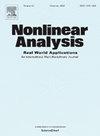A class of nonlinear parabolic PDEs with variable growth structure applied to multi-frame MRI super-resolution
IF 1.8
3区 数学
Q1 MATHEMATICS, APPLIED
引用次数: 0
Abstract
This research paper proposes a novel parabolic model driven by a nonlinear operator with a variable exponent applied to multi-frame image super-resolution. Our idea is based essentially on enhancing the classical image super-resolution models by considering novel regularized terms involving -growth structure. This regularization leads to deriving a new nonlinear parabolic PDE with nonstandard growth conditions. We start initially by examining the theoretical solvability of our model. We employ the so-called variable exponents Lebesgue-Sobolev spaces to establish an appropriate functional framework for the theoretical investigation of our proposed model. We then apply the Faedo–Galerkin method to establish both the existence and uniqueness of a weak solution for the proposed model. To validate the effectiveness of our model in the multi-frame super resolution (SR) context, we conduct numerical experiments on Magnetic Resonance Images (MRI) featuring diverse characteristics, including corners and edges, while applying different warping, decimation and blurring matrices with noises on the low-resolution (LR) images. We initiate the evaluation by introducing an adaptive discrete scheme of the proposed model. To prove the robustness of our approach, we subject our images to varying levels of noise while conducting many behavior tests on some parameters with major contributions. Additionally, we perform simulations on real data (videos) to show the superiority of the proposed model. The obtained high resolution (HR) results demonstrate notable efficiency and robustness against noise, outperforming the competitive models visually and quantitatively.
一类具有可变增长结构的非线性抛物 PDEs 应用于多帧 MRI 超分辨率
本研究论文提出了一种由具有可变指数的非线性算子驱动的新型抛物线模型,并将其应用于多帧图像超分辨率。我们的想法主要是通过考虑涉及 p(x) 增长结构的新型正则化项来增强经典图像超分辨率模型。通过这种正则化,可以推导出具有非标准增长条件的新非线性抛物线 PDE。我们首先研究了模型的理论可解性。我们利用所谓的可变指数 Lebesgue-Sobolev 空间,为我们提出的模型的理论研究建立了一个适当的函数框架。然后,我们应用 Faedo-Galerkin 方法为所提模型建立弱解的存在性和唯一性。为了验证我们的模型在多帧超分辨率(SR)背景下的有效性,我们在具有不同特征(包括边角和边缘)的磁共振图像(MRI)上进行了数值实验,同时在低分辨率(LR)图像上应用了不同的扭曲、抽取和模糊矩阵以及噪声。我们通过引入所提模型的自适应离散方案来启动评估。为了证明我们方法的鲁棒性,我们对图像进行了不同程度的噪声处理,同时对一些有重大贡献的参数进行了许多行为测试。此外,我们还在真实数据(视频)上进行了模拟,以显示所提模型的优越性。所获得的高分辨率(HR)结果显示了显著的效率和对噪声的鲁棒性,在视觉上和定量上都优于竞争模型。
本文章由计算机程序翻译,如有差异,请以英文原文为准。
求助全文
约1分钟内获得全文
求助全文
来源期刊
CiteScore
3.80
自引率
5.00%
发文量
176
审稿时长
59 days
期刊介绍:
Nonlinear Analysis: Real World Applications welcomes all research articles of the highest quality with special emphasis on applying techniques of nonlinear analysis to model and to treat nonlinear phenomena with which nature confronts us. Coverage of applications includes any branch of science and technology such as solid and fluid mechanics, material science, mathematical biology and chemistry, control theory, and inverse problems.
The aim of Nonlinear Analysis: Real World Applications is to publish articles which are predominantly devoted to employing methods and techniques from analysis, including partial differential equations, functional analysis, dynamical systems and evolution equations, calculus of variations, and bifurcations theory.

 求助内容:
求助内容: 应助结果提醒方式:
应助结果提醒方式:


